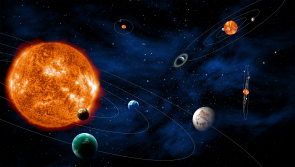ESA selects planet-hunting PLATO mission
19 February 2014
A space-based observatory to search for planets orbiting alien stars has been selected today as ESA's third medium-class science mission. It is planned for launch by 2024.The PLATO – Planetary Transits and Oscillations of stars – mission was selected by ESA's Science Programme Committee for implementation as part of its Cosmic Vision 2015–25 Programme.
 |
| Searching for exoplanetary systems. Credit: ESA/C. Carreau |
The mission will address two key themes of Cosmic Vision: what are the conditions for planet formation and the emergence of life, and how does the Solar System work?
PLATO will monitor relatively nearby stars, searching for tiny, regular dips in brightness as their planets transit in front of them, temporarily blocking out a small fraction of the starlight.
By using 34 separate small telescopes and cameras, PLATO will search for planets around up to a million stars spread over half of the sky.
It will also investigate seismic activity in the stars, enabling a precise characterisation of the host sun of each planet discovered, including its mass, radius and age.
When coupled with ground-based radial velocity observations, PLATO's measurements will allow a planet's mass and radius to be calculated, and therefore its density, providing an indication of its composition.
The mission will identify and study thousands of exoplanetary systems, with an emphasis on discovering and characterising Earth-sized planets and super-Earths in the habitable zone of their parent star – the distance from the star where liquid surface water could exist.
"PLATO, with its unique ability to hunt for Sun–Earth analogue systems, will build on the expertise accumulated with a number of European missions, including CoRot and Cheops," says Alvaro Giménez, ESA's Director of Science and Robotic Exploration.
"Its discoveries will help to place our own Solar System's architecture in the context of other planetary systems.
"All M3 mission candidates presented excellent opportunities for answering the major scientific questions that define our Cosmic Vision programme."
The four other mission concepts competing for the M3 launch opportunity were: EChO (the Exoplanet CHaracterisation Observatory), LOFT (the Large Observatory For x-ray Timing), MarcoPolo-R (to collect and return a sample from a near-Earth asteroid) and STE-Quest (Space-Time Explorer and QUantum Equivalence principle Space Test).
PLATO joins Solar Orbiter and Euclid, which were chosen in 2011 as ESA's first M-class missions. Solar Orbiter will be launched in 2017 to study the Sun and solar wind from a distance of less than 50 million km, while Euclid, to be launched in 2020, will focus on dark energy, dark matter and the structure of the Universe.
PLATO will be launched on a Soyuz rocket from Europe's Spaceport in Kourou by 2024 for an initial six-year mission. It will operate from L2, a virtual point in space 1.5 million km beyond Earth as seen from the Sun.
Data from ESA's recently launched Gaia mission will help PLATO to provide precise characteristics of thousands of exoplanet systems. These systems will provide natural targets for detailed follow-up observations by future large ground- and space-based observatories.
For further information, please contact:
ESA Media Relations Office
Communication Department
Tel: + 33 1 53 69 72 99
Fax: + 33 1 53 69 76 90
Email: media![]() esa.int
esa.int

